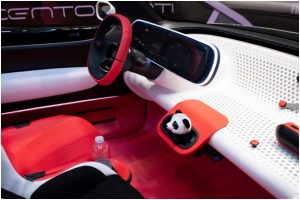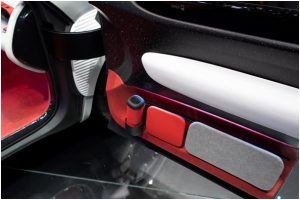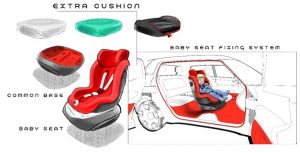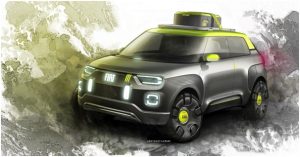 On display at this year’s Geneva Motor Show Fiat’s Concept Centoventi is fundamentally a “blank canvas”ready to be painted to suit the customer’s tastes and needs at any time of their life, without customisation restrictions linked to the time of purchase. In fact, it will be produced in just one colour, which customers will be able to personalise using the “4U” program, with a choice of 4 roofs, 4 bumpers, 4 wheel covers and 4 external wrappings. Owners will no longer have to wait for new special editions or facelifts, as they can “change” their cars any day they like. At the launch, 120 additional accessories will be available.
On display at this year’s Geneva Motor Show Fiat’s Concept Centoventi is fundamentally a “blank canvas”ready to be painted to suit the customer’s tastes and needs at any time of their life, without customisation restrictions linked to the time of purchase. In fact, it will be produced in just one colour, which customers will be able to personalise using the “4U” program, with a choice of 4 roofs, 4 bumpers, 4 wheel covers and 4 external wrappings. Owners will no longer have to wait for new special editions or facelifts, as they can “change” their cars any day they like. At the launch, 120 additional accessories will be available.
The functional spirit of the brand pays tribute to its 120 years of history, with a modern take on some trademark style elements that hint to the Panda of the 1980s. The car embodies Fiat’s “less is more” concept, which means getting rid of everything unnecessary and complex in a car to provide more space for people (More You), attention to the environment and the community (More Care) and for the brand’s DNA in terms of values and looks (More Fiat).
Except for six features (bumpers, polycarbonate roof, colour, Lingotto instrument cluster, batteries and digital tailgate), which can only be installed at retailers, the other 114 accessories specially designed by Mopar – including the sound system, the dashboard and door storage compartments, the seat cushions, etc. – can also be purchased on-line and fitted by the customer at their own home. What’s more, some simply structured accessories, such as a cup-holder or a document-holder, for example, can actually be printed using a 3D printer, in the owner’s home, at their dealership or at a specialist printing shop.
Modular, roomy and well-litthe cockpit, which is totally reconfigurable can accommodate up to four people.Various parts of the interior are created on the “plug and play” principle. The dashboard has small holes int o which a multitude of additional components, of any shape and function, can be fitted, thanks to the patentedinterlocking mounting system.The same approach is found on the door panels, which are totally customisable with flat surfaces and minimal design, they can be fitted with storage pockets, bottle holders and audio speakers as and when required. The design tips its hat to the Panda’s famous, historic “pocket”.
o which a multitude of additional components, of any shape and function, can be fitted, thanks to the patentedinterlocking mounting system.The same approach is found on the door panels, which are totally customisable with flat surfaces and minimal design, they can be fitted with storage pockets, bottle holders and audio speakers as and when required. The design tips its hat to the Panda’s famous, historic “pocket”.
The seat is made from an innovative plastic produced using an exclusive, patented production process involving a new plastic formulated using polyolefin resins. The end result is a material three times lighter than other mouldable plastics, like foams – and what’s more it is coloured directly in the batch, meaning it has no external coating, looks attractive and is soft to the touch. Furthermore, this innovative plastic is antimicrobic, UV-resistant and completely washable. It can be coloured in an infinite variety of shades and colours.The “3D knit” technology of the seat backs and head restraints, made from 100% recycled yarns, is just as innovative. This technology has already been successfully used not only in the sports sector, such as for trainers or other technical-sports garments, but also in interior design for creating innovative, functional, flexible seating. This particular process is able to create fabric weaves of varying cross-section, which avoid the generation of waste materials requiring disposal.

Just as revolutionary, the instrument panel is available in two solutions: the first, makes the smartphone the heart of the system, in combination with the cluster’s main 10″ screen, while the second, more traditional option features a second integrated display, giving a cluster of 20″.Anyone seeking a more traditional solution, can opt for the “Lingotto” instrument cluster.
The standard Centoventi comes with an open roof, which is of course closed by a “cap”. As the other details, the roof can also be customised by choosing one of the available roof solutions – two-colour polycarbonate top, canvas soft top, integrated cargo box and even a roof integrating an innovative solar panel. The 50 Watts generated by the solar panel will keep the car cool when it is parked and will power the innovative digital display arranged under the rear tailgate.

The electrical power source that drives the Centoventiconsists of a set of modular batteries offering great possible flexibility of use. As standard, the car comes with a factory-mounted battery with a range of 62 miles. But if a longer range is needed, up to 3 additional batteries, giving an increase of 62 miles each, can be purchased or hired. The extra batteries are installed underneath the floor of the car, by the service network. A sliding rail which supports and connects the batteries makes their installation or removal particularly quick and easy. An additional battery, for mounting under the seat, is also available; it can be disconnected and put on charge directly in the user’s home or garage, just like the battery of a modern e-bike. The total range which can be achieved is 310 miles.
Impressively, the way the car is designed, with the roll centre exactly midway between the two axle shafts, and the placing of the batteries underneath the vehicle’s centre of gravity, mean that the car’s weight distribution and handling are unchanged regardless of the number of batteries installed. The braking system is suitably sized to ensure maximum deceleration even when fully laden.

The multiple charging socket is located at the bottom of the windscreen. This is a cable reel housed underneath the trim, which eliminates the need for a cable cavity in the boot and, thanks to its central position, is equidistant from charging points on either side, or can act as a hub for several vehicles in case of energy sharing. The socket lights up in the dark and can be used as an electric torch and windscreen defrosting device.
Fiat Concept Centoventi main technical data
Length: 3680 mm
Height: 1527 mm
Width: 1740 mm (with door mirrors 1846 mm)
Wheelbase: 2430 mm
Front overhang: 658 mm
Rear overhang: 592 mm
FIAT Chrysler AutomobilesPress Office

![Fiat Motor Club [GB]](https://fiatmotorclubgb1.netfirms.com/wp-content/uploads/2017/11/Website-Header-v3.jpg)